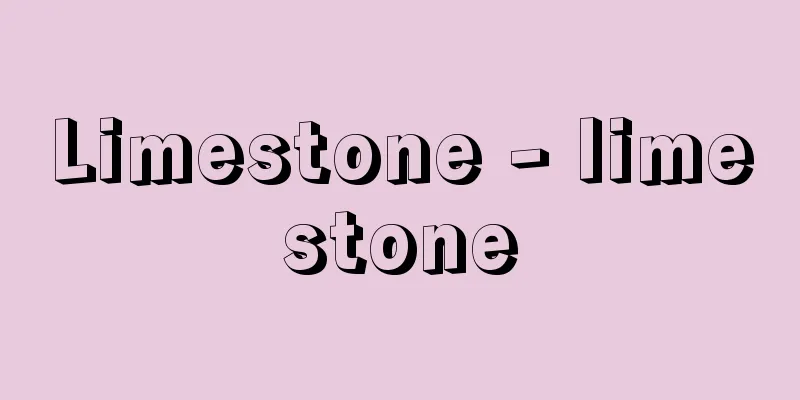Limestone - limestone

|
A type of sedimentary rock whose main component is calcium carbonate. It is mainly composed of calcite, and is generally fine-grained and massive, and often contains fossils. It is white or gray in color, but depending on the impurities it can be yellow, reddish brown, dark gray, etc. It occurs in the form of massive or dome-shaped rock bodies, or in layers. It is formed in shallow tropical and subtropical waters where there is little detrital material supplied from land, for example in coral reefs, where it is organically precipitated and fixed by organisms that secrete calcium carbonate skeletons or shells, or by direct inorganic precipitation from seawater. Some are made from calcareous detritus that is the secondary destruction of limestone formed in this way. The materials that make up limestone include various types of fossils such as foraminifera, fusulina, calcareous algae, crinoids, corals, bivalves, and brachiopods, as well as oolite (staghorn rock) and pellets, and the calcareous mud (micrite) that fills the gaps between them, or the calcite cement (sparite) that crystallizes in the gaps. The ratio of these quantities is used to classify limestone, as it reflects the environment in which the limestone was formed. For example, if the calcareous mud has been washed out and reduced, cemented with sparite, and fossils have been crushed or ground and selected, it indicates that the water flow in the area where the limestone was formed was stronger. Clastic limestone, like clastic rocks, is divided into calcareous conglomerate (calcirudite), calcareous sandstone (calcarenite), and calcareous mudstone (calcilutite). Throughout the geological ages, limestone is well developed from the Ordovician to Silurian periods of the Paleozoic Era, the Carboniferous to Permian periods (Permian is sometimes used for continental strata), and the Jurassic to Cretaceous periods of the Mesozoic Era. In Japan, there are many limestones from the Silurian period of the Paleozoic Era and the late Carboniferous to Permian period, and they have also developed as raised coral reefs in the Quaternary layers of the Ryukyu Islands. Both contain many fossils and are used to determine geological ages. They are also useful for estimating the state of the paleoenvironment and the biological world at the time of deposition, so they are important not only in geological history and paleontology, but also in fields that consider paleoceanography and changes in the global environment. In Japan, fusulina limestone from the Paleozoic Era and lepidocyclina limestone from the Cenozoic Era are known to indicate specific eras. Most of the Carboniferous and Permian limestones in Japan were formed as coral reefs in tropical regions, and were carried to trenches by the movement of oceanic plates and incorporated into accretionary complexes of later eras. Limestone has a wide range of uses, including as stone material known as marble, as well as being used in large quantities as a raw material for cement, carbide, fertilizer, and steel manufacturing. When used as an industrial raw material, it is called limestone. It is also said that about half of the world's oil reserves are found in limestone, making it an important oil-bearing layer. The main production areas in Japan include Nagaiwa in the Kitakami Mountains in the south, Kuzuu in the Ashio Mountains, Mount Buko in the Kanto Mountains, Aomi in Itoigawa City, Niigata Prefecture, Akasaka Town, Ogaki City, Gifu Prefecture, Mount Torigata in Kochi Prefecture, Taishaku Gorge in Hiroshima Prefecture, Akiyoshidai in Yamaguchi Prefecture, and Hiraodai in Fukuoka Prefecture. [Saito Yasuji] [References] | | | | | | | reef| | | | | | |Source: Shogakukan Encyclopedia Nipponica About Encyclopedia Nipponica Information | Legend |
|
炭酸カルシウムを主成分とする堆積岩(たいせきがん)の一種。主として方解石からなり、一般に細粒・塊状の岩石で、化石をよく含んでいる。色は白色または灰色であるが、含まれる不純物によって黄色、赤褐色、暗灰色などとなる。産状としては、塊状あるいはドーム状の岩体をなす場合と、層状をなす場合とがある。陸地から供給される砕屑(さいせつ)物が少ない熱帯・亜熱帯の浅海域で、たとえばサンゴ礁のように、炭酸石灰質の骨格あるいは殻を分泌する生物によって有機的に沈殿固定されるか、または海水から直接無機化学的に沈殿して形成される。こうして形成された石灰岩が二次的に壊されてできた石灰質の砕屑物からつくられたものもある。 石灰岩を構成する物質には、有孔虫、紡錘虫(フズリナ)、石灰藻、ウミユリ、サンゴ、二枚貝、腕足貝などいろいろな種類の化石や、オーライトoolite(鮞状(じじょう)岩)とペレットpelletなどと、それらのすきまを埋める石灰質の泥(ミクライトmicrite)あるいはすきまに晶出した方解石の膠結(こうけつ)物(スパライトsparite)がある。これらの量比は、石灰岩の形成環境を反映しているので、石灰岩の分類に用いられる。たとえば、石灰泥が洗い出されて減少し、スパライトで膠結され、化石などが破砕あるいは円摩され淘汰(とうた)されていれば、石灰岩形成の場の水流がより強かったことがわかる。砕屑性の石灰岩では、砕屑岩と同じように、石灰礫(れき)岩(石灰質ルーダイトcalcirudite)、石灰砂岩(石灰質アレナイトcalcarenite)、石灰泥岩(石灰質ルータイトcalcilutite)に分けられる。 地質時代全般を通して、石灰岩は古生代のオルドビス紀からシルル紀、石炭紀からペルム紀(陸成層には二畳紀を使うことがある)、および中生代のジュラ紀から白亜紀にかけてよく発達している。日本では古生代のシルル紀、石炭紀後期からペルム紀の石灰岩が多く、琉球(りゅうきゅう)列島の第四紀層にも隆起サンゴ礁として発達している。いずれも化石を多く含み、地質時代の決定に利用されるほか、堆積当時の古環境や生物界のようすの推定に役だつため、地史学や古生物学のみならず、古海洋や地球環境の変動を考察する分野でも重要である。日本では、特定の時代を示すものとして、古生界のフズリナ石灰岩、新生界のレピドシクリナ石灰岩が知られている。日本の石炭紀・ペルム紀石灰岩のほとんどは、熱帯域でサンゴ礁として形成されたもので、海洋プレートの移動に伴って海溝まで運ばれ、後の時代の付加体に取り込まれたものである。 石灰岩の利用面は広く、いわゆる大理石として石材に利用されるほか、セメント、カーバイド、肥料などの原料や製鉄などに大量に使われている。これら工業用原料として利用される場合には石灰石とよばれている。また世界の石油埋蔵量の約半分は石灰岩中にあるといわれ、含油層としても重要である。 日本のおもな産地として、南部北上山地長岩、足尾山地葛生(くずう)、関東山地武甲(ぶこう)山、新潟県糸魚川(いといがわ)市青海(おうみ)、岐阜県大垣市赤坂町、高知県鳥形(とりがた)山、広島県帝釈(たいしゃく)峡、山口県秋吉台、福岡県平尾台などがある。 [斎藤靖二] [参照項目] | | | | | | | | | | | | | | | |出典 小学館 日本大百科全書(ニッポニカ)日本大百科全書(ニッポニカ)について 情報 | 凡例 |
<<: Limestone plants - Limestone plants
>>: Lime sulfur (English name)
Recommend
Oyabe [city] - Oyabe
A city in the western part of Toyama Prefecture. I...
Blood Island
…Hematopoietic tissues are found in various organ...
Creation - Creation
This refers to land reclamation. In the Edo period...
Joint transport - Kyodounso
…As transportation, communication, and financial ...
Nankai Road - Something Color
During the Edo period, Edo became a major consumer...
Galata
…In 1853, the Baroque-style Dolmabahçe Sarayı was...
medical jurisprudence
… [Historical Background] As the Code of Hammurap...
Exochorda serratifolia (English spelling) Exochordaserratifolia
… [Mitsuru Hotta]... *Some of the terminology tha...
Vera Fyodorovna Panova
Soviet female writer. Born in Rostov-on-Don. From...
Direct reading balance (direct reading balance)
A balance that can quickly and accurately measure ...
《Kiki》 - Kiki
...The first volume of the Six National Histories...
Ansei Purge - Ansei no Taigoku
In 1858 (Ansei 5), the Edo Shogunate's Chief ...
Katsura
...In the Edo period, when the five-part program ...
Photo
〘 noun 〙① To make offerings to portraits of gods, ...
"Pilgrimage of the Six Paths of Pure Water and Pure Gentian"
The main scenes are "Kiyomizu-dera Scene&quo...









